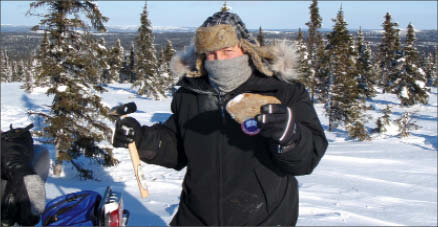With several recent high-profile iron ore acquisitions in Eastern Canada, Cap-Ex Ventures (CEV-V) has picked an opportune time to re-launch as a Labrador Trough-focused exploration company.
Cap-Ex started to gain momentum after announcing in January that it would acquire a group of iron ore properties near Schefferville, Que., though its qualifying transaction was an option deal
on a Yukon gold property last
August.
The initial iron properties include: blocks 103, 44 and Lac Connelly for a total of 90 sq. km, all within 30 km of the town of Schefferville. In February, the company added an option agreement on the Redmond properties, consisting of 28 sq. km, sitting 12 km southeast of the town.
The properties are near Labrador Iron Mines‘ (LIM-T) and New Millennium Capital‘s (NML-V) main iron ore projects.
Cap-Ex is led by Brett Matich as president and CEO as of mid-March. Matich recently came to Canada after directing base metal companies in Australia, where he managed to identify historic but prospective iron and nickel projects. His efforts to secure a large zinc project in Greenland for Ironbark Zinc (IBG-A) had him working with a vendor that also had iron projects in the Schefferville area which, after two years of work, had Matich bringing them to Cap-Ex for acquisition and exploration.
Matich explains in a phone interview that Canada is still prospective and lags behind Australia in the iron ore industry and he sees significant growth potential.
“The iron ore sector is probably one of the only commodity sectors where Canada is actually a number of years behind Australia,” says Matich. “If Canada is going to chase up on the iron ore side… there’s going to be a lot more activity there.”
However, in Eastern Canada, some evidence of increased activity exists. Labrador Iron Mines expects to start its direct shipping ore operation this year; New
Millennium has signed a binding development deal with Tata Steel, in which the major has committed to finance up to $4.85 billion; Cliffs Natural Resources (CLF-N) bought Consolidated Thompson Iron Mines for $4.9 billion in January; and a little farther afield ArcelorMittal (MT-N) and Nunavut Iron Ore engaged in a bidding war for Baffinland Iron Mines’ Mary River iron ore project that ended with both companies getting a stake.
Matich thinks these plays will add value to the whole area, and majors will be targeting anywhere near their infrastructure to make the most on investments.
“Where you get a massive amount of infrastructure getting built,” says Matich, “it increases the value of any iron ore deposit in that region… it’s just opened up that whole iron ore belt.”
As to Cap-Ex’s own properties, block 103 is the most advanced after Adriana Resources (ADI-V) conducted 670 line km of airborne survey in 2008. According to Matich, Adriana asked for an extension on the option timeline, but the vendor instead gave the option deal to Cap-Ex after Matich convinced the vendor that Cap-Ex would quickly advance the property.
Cap-Ex picked up where Adriana left off and had the data modeled and interpreted, reporting in January that the results indicate that “block 103 covers some of the most intense positive magnetic responses in the iron ore belt.”
The company’s Redmond properties cover 6.5 km of strike of historic iron ore occurrences, while on block 44 encouraging iron ore content has been identified but not followed up yet.
The deposits are composed of Lake Superior-type iron formations consisting of banded sedimentary rocks. The bands consist primarily of iron oxides, magnetite and hematite within quartz-rich rock, with variable amou-nts of silicate, carbonate and sulphide lithofacies.
Adding to its property holdings, Cap-Ex announced in early March that it had staked 101 sq. km over six properties in the area. Three properties abut block 103, two adjoin the Redmond property and the final property is several kilometres northwest of Redmond.
And in early April, the company entered into agreements for three more properties in the area and staked more ground. Cap-Ex’s land package in the area totals 320 sq. km.
Cap-Ex also closed a $12.7-million, 11.6-million-unit financing in March
to fund exploration work this year. Cap-Ex now has 41 million shares outstanding, or 58.2 million fully diluted.
For 2011 the company plans to drill 10,000 metres on block 103 while Redmond and block 44 will see airborne surveys, sampling and geophysics. The $6.1-million exploration budget also includes a preliminary resource estimate and metallurgical testwork.
To secure blocks 103 and 44, Cap-Ex paid $275,000 and issued 5 million shares to Mandu Resources, Bedford Resources Partners, and 743584 Ontario, who retain a 1.8% royalty on iron ore produced from the properties. For the Redmond properties, Cap-Ex has to pay $100,000 in cash plus $1 million in shares and $1 million in exploration over 3 years, while vendor Kal Malhi keeps a 2% net smelter return royalty. The company is no longer optioning into the Yukon property.
Cap-Ex’s share price climbed from 35¢ when the first Schefferville deal was announced to $1.56 on April 8, a day after the latest acquisition news was released.
Labrador Iron Mines and New Millennium have, however, encountered resistance from the Quebec Innu who claim virtually all of Labrador as ancestral territory. The two companies have now reached agreements with the local bands, but not before roadblocks and delayed negotiations. Matich says the difficult deals being sealed now will set a precedent and likely make future deals more straightforward.


Be the first to comment on "Cap-Ex focuses on Labrador iron"